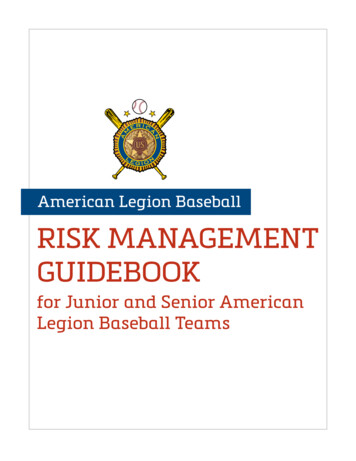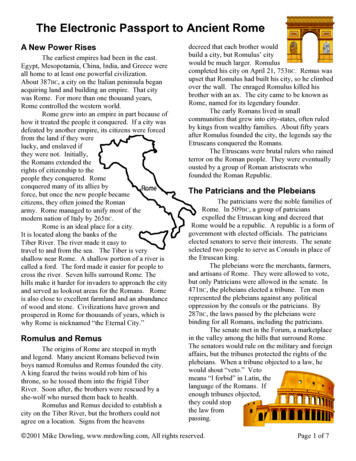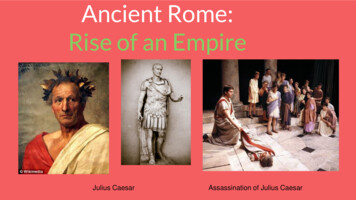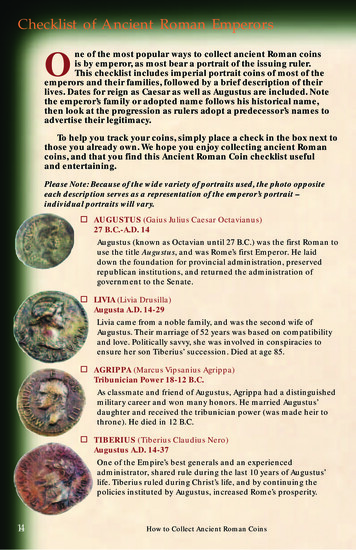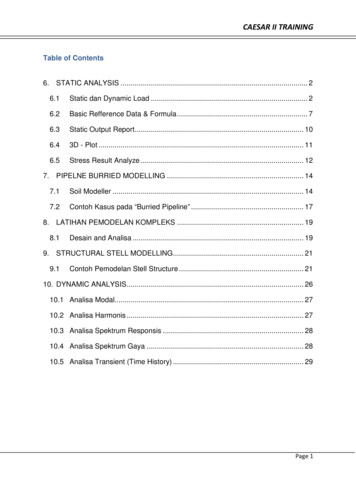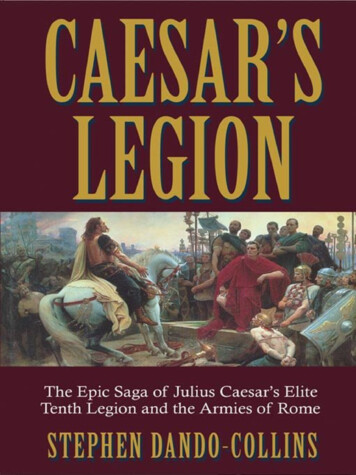
Transcription
C A E S A R ’SL E G IO N:THE EPIC SAGA OFJULIUS CAESAR’S ELITETENTH LEGION ANDTHE ARMIES OF ROMESTEPHEN DANDO-COLLINSJohn Wiley & Sons, Inc.
flast.qxd12/5/014:49 PMPage xiv
ffirs.qxd12/5/014:47 PMPage iC A E S A R ’SL E G IO N:THE EPIC SAGA OFJULIUS CAESAR’S ELITETENTH LEGION ANDTHE ARMIES OF ROMESTEPHEN DANDO-COLLINSJohn Wiley & Sons, Inc.
Copyright 2002 by Stephen Dando-Collins. All rights reservedPublished by John Wiley & Sons, Inc., New YorkNo part of this publication may be reproduced, stored in a retrieval system, or transmittedin any form or by any means, electronic, mechanical, photocopying, recording, scanning,or otherwise, except as permitted under Section 107 or 108 of the 1976 United StatesCopyright Act, without either the prior written permission of the Publisher, or authorization through payment of the appropriate per-copy fee to the Copyright Clearance Center,222 Rosewood Drive, Danvers, MA 01923, (978) 750-8400, fax (978) 750-4744. Requeststo the Publisher for permission should be addressed to the Permissions Department, JohnWiley & Sons, Inc., 605 Third Avenue, New York, NY 10158-0012, (212) 850-6011, fax(212) 850-6008, email: PERMREQ@WILEY.COM.This publication is designed to provide accurate and authoritative information in regard tothe subject matter covered. It is sold with the understanding that the publisher is notengaged in rendering professional services. If professional advice or other expert assistanceis required, the services of a competent professional person should be sought.This title is also available in print as ISBN 0-471-09570-2. Some content that appears inthe print version of this book may not be available in this electronic edition.For more information about Wiley products, visit our web site at www.Wiley.com
ftoc.qxd12/5/014:48 PMPage s NotevxiiixvStaring Defeat in the FaceImpatient for GlorySavaging the Swiss, Overrunning the GermansConquering GaulInvading BritainRevolt and RevengeEnemy of the StateBroken PromisesThe Race for DurrësA Taste of DefeatThe Battle of PharsalusThe Sour Taste of VictoryThe Murder of Pompey the GreatThe Power of a Single WordThe North African CampaignCaesar’s Last BattleMark Antony’s MenPhilippi and ActiumIn the Name of the EmperorKnocked into Shape by CorbuloOrders from the EmperorObjective 3195205217224iii
ftoc.qxd12/5/014:48 PMivxxiiixxivxxvPage ivcontentsThe End of the Holy CityMasadaLast Daysappendix aappendix bappendix cappendix dappendix eappendix fappendix gGlossaryIndexThe Legions of Rome, 30 b.c.–a.d. 233The Reenlistment FactorThe Uniqueness of the Legion Commandsin Egypt and JudeaThe Naming and Numbering System of theRoman LegionsThe Title “Fretensis”Imperial Roman Military Ranks and TheirModern-Day 3309
flast.qxd12/5/014:49 PMPage vAT L A S:1. “The West,” First Century b.c.2. Britain and Gaul, 58–50 b.c.3. “The East,” First Century b.c.4. Spain, First Century b.c.5. Southern Italy, the Balkans, Greece, and Asia, First Century b.c.6. The Middle East, First Century a.d.v
flast.qxd12/5/014:49 PMPage HANNGAULBAY OFBISCAYDuro R.CISALPINETHESSALYGAULTRANSALPINERavenna ILLYRPiacenzaGAULICADRubicon R. SPAINus RSPAINGuadalquivir susConstantineCivil War battle or siegeCivil War raidITALY BrindisiSICILYBôneMAURETANIARRHSE ENA IASEDurrësACapuaN ViboActiumAthensMarsalaMessinaReggio IONIAN ACHAEAUtiqueBalearicIslesCórdobaMundaEl RocadilloICCorfiniumRome NUMIDIASEAEPIRUSCRETEBagradas R.AFRICA“The West,” First Century B.C. 2001 by D. L. McElhannonCYRENAICA
4:49 PMPage viiSouthern BritainColchesterCATUVELLAUNIeNNORTHSEAR.am sThNorthForelandR.MedwayKENTCANTIACIIsle of WightBRITAINNORTHSEAArea of InseturStoR. traitR.einSeSambre R.TENCTHERINERVII EBURONESENGLISH CHANNELBoulogneTongres ETICARNUTES nBAY IUxellodunumIsle of WightSaône R.Re R.12/5/01PyreneesNarbonneMounNEARER tainsSPAIN 2001 by D. L. ANSEABritain and Gaul, 58–50 B.C.
ADRMCUIRALYSELCITIIA.“The East,” First Century B.C.Site of battle or siegeSite of raidThapsusCarthageSousseRuspinaAFRICAas CYPRUSJerusalemJUDEAAntiochSYRIAPelusium 2001 by D. L. GENEN4:49 AITALYTHRACERome rsalaLESBOSSICILY ReggioUtiqueTRANSALPINEGAULflast.qxdPage viii
NIACádiz 2001 by D. L. McElhannoniverivirMundaCórdobaRiverEl RocadilloSevilledalquuaoEbrNEARER SPAINFARTHER SPAINRiverTagusRrouDCANTABRIANMTSerRivLUSITANCivil War battle or siegeSpain, FirstCentury B.C.TarragonaLéridaR.greeSES MTSENEPYR4:49 PMG12/5/01Cinca R.flast.qxdPage ix
flast.qxd12/5/014:49 PMPage xSouthern Italy, the Balkans,Greece, and Asia,TriesteILLYFirst Century B.C.RICUSite of battle or siegeSite of raidSite of amphibious NIHE ARR ORFULESBOS MytileneFarsalaViboMessinaActiumASIADelphi AEGEANSEAReggioACHAEA AthensUIRSSICILYStrait ofMessinaMEDITERRANEANSEA 2001 by D. L. McElhannonCOSRHODESIONIANSEACRETE
flast.qxd12/5/014:49 PMPage xiSEABLACKPONTUSArtaxata.Rrat CIACarrhae RUSMEDITERRANEANSEACaesarea JerusalemAscalone DeltaNil AlexandriaCaesareaPhilippiSYRIAPelusium MasadaArea of InsetPtolemaisSEA OFGALILEEGishalaJefatGamalaTiberiusMt. Carmel JUDEANJordan R.Babylon chaerusIDUMAEA HebronMasadaLodDEAD SEABattle siteMountain Provincial capitalLegion baseLegion detachmentRoman siegeParthian siegeREDSEAEGYPTNABATAEAThe Middle East,First Century A.D. 2001 by D. L. McElhannonPalestine 66–71 A.D.
flast.qxd12/5/014:49 PMPage xii
flast.qxd12/5/014:49 PMPage xiiiACKNOWLEDGMENTS:This book would not have been possible without the immense help provided over many years by countless staff at libraries, museums, and historicsites throughout the world. To them all, my heartfelt thanks. Neither theynor I knew at the time what my labor of love would develop into. Mythanks, too, to those who read my research material as it blossomed intomanuscript form and made invaluable suggestions.Most particularly, I wish to record my appreciation for the role playedby three people in bringing this work to fruition. First, I want to thankStephen S. Power, senior editor at John Wiley & Sons, for his enthusiasm,encouragement, vision, and guidance.Then there is Richard Curtis, my wonderful New York literary agent,who over a period of several years supported my aspirations, provided direction, and finally married me with an excellent publishing house. It wasRichard who suggested I break down one massive tome on all the legionsinto histories of individual legions. Without him, there would have beenno Caesar’s Legion. In this increasingly impersonal new-fashioned electronic age, I can certify without reservation that in a brownstone on theUpper East Side there sits a man who embodies all the old-fashioned qualities that a writer dreams of finding in a literary agent. For a man whoembraces technology and is at the forefront of the electronic publishingrevolution, you really are a gentleman of the old school, Richard.And then there is Louise, my wife of almost twenty years. What aroller-coaster ride she has taken with me all these years, never with a wordof complaint, always with words of encouragement. How can I describethe role she has played in making this book, in making this writer? Romanhistorian Tacitus put it best, I think, in his Agricola. He was describing therelationship between his mother-in-law, Domitia, and Agricola, his fatherin-law, but his words equally express the way I feel about the relationshipmy beloved wife and I have shared these past two decades: “They lived inrare accord, maintained by mutual affection and unselfishness; in such apartnership, however, a good wife deserves more than half the praise, justas a bad one deserves more than half the blame.”xiii
flast.qxd12/5/014:49 PMPage xiv
A U T HOR ’S N OT E:Never before has a comprehensive history of an individual Roman legionbeen written. This book comes out of thirty years’ research on the Romanmilitary, in the process of which it was possible to identify the fifty Augustan and post-Augustan legions raised between 84 b.c. and a.d. 231 and tocompile detailed histories of most of them.The works of numerous classical writers who documented the wars,campaigns, battles, skirmishes, and most importantly the men of thelegions of Rome have come down to us. Authors such as Julius Caesar,Appian, Plutarch, Tacitus, Suetonius, Polybius, Cassius Dio, Josephus, Plinythe Younger, Seneca, Livy, Arrian. Without their labors this book wouldnot have been possible.Enough material exists, from sources classical and modern—detailed inthe appendices of this work—to write whole books on the 14th GeminaMartia Victrix, the legion that beat Boadicea (or Boudicca, as she wasactually called); on the 3rd Augusta, the legion that saved the life of St.Paul the Apostle; on the 6th Victrix, the legion that kidnapped Cleopatraand gave rise to Julius Caesar’s most famous message, “I came, I saw, I conquered”; and on the 12th Fulminata, the legion that gained its fame andits name in Marcus Aurelius’s battles against the Germans so colorfullydepicted in the movie Gladiator. To mention just a few.But unquestionably the most renowned legion in its day was the 10th—Legio X. In fact, it was described as “world famous” when it arrived to jointhe Judean offensive of a.d. 67. Personally raised by Julius Caesar, the10th Legion is on record as taking the leading role in all his battles, froma bloody initiation in Spain to the conquest of Gaul, the invasion ofBritain, and the battles of the civil war against Pompey the Great thateventually made Caesar Dictator of Rome. The 10th Legion marched forMark Antony and for Augustus. It whipped the Parthians under Corbulo,it squashed the Jewish Revolt for Vespasian, and it took the Temple atJerusalem for Titus. It conquered Masada.During the research for this work, light was shed on a number of issuesrelating to the legions, such as the uniqueness of legion commands inxv
xvia u t hor ’s n ot eEgypt and Judea. But the most enlightening aspect of all was the reenlistment factor. The legions of Rome were recruited en masse, and the survivors discharged en masse at the end of their enlistment—originally aftersixteen years, later, after twenty. Replacements were not supplied in theinterim. The reenlistment factor explains why particular units were crushedin this battle or that—in some they were made up of raw recruits; in others, they were comprised of men of thirty-nine and fifty-nine about to gointo retirement. A later appendix elaborates on the reenlistment factor.Now to the matter of dates and names. For the sake of continuity, theRoman calendar—which varied by up to two months from our own—isused throughout this work. Place names are generally first referred to intheir original form and thereafter by modern name, where known, to permit readers to readily identify locations involved. Personal names familiarto modern readers have been used instead of those technically correct—Antony instead of Antonius, Julius Caesar for Gaius Caesar, Octavian forCaesar, Pilate for Pilatus, Vespasian instead of Vespasianus, etc.In the nineteenth and twentieth centuries it became fashionable forsome authors to refer to legions as regiments, cohorts as battalions, maniples as companies, centurions as captains, tribunes as colonels, and legatesas generals. In this work, Roman military terms such as legion, cohort,maniple, and centurion have been retained, as it’s felt they will be familiar to most readers and better convey the flavor of the time.However, because of a lack of popular familiarity with the term“legate,” “general” and/or “brigadier general” are used here. “Colonel” and“tribune” are both used, to give a sense of relative status. Likewise, so thatreaders can relate to their ranks in comparison to today’s military, whenreferred to in the military sense “praetors” are given as “major generals”and “consuls” as “lieutenant generals.” In this way, reference to a lieutenant general, for example, will immediately tell the reader that the figure concerned has been a consul.I am aware that this approach to ranks is akin to having a foot in twocamps and may not please purists, but my aim has been to make this bookbroadly accessible.This is the story of the men of the 10th Legion. Men who made Romegreat—one or two extraordinary men, and many more ordinary men whooften did extraordinary things. In many ways they were not unlike us. Butone wonders if we today could even begin to do what they did, to endurewhat they endured, to achieve what they achieved.
I:STARING DEFEATIN THE FACEt was a great day to die. And before the sun had set, thirty-fourthousand men would lose their lives in this valley. The men ofthe 10th Legion would have had no illusions. They knew thatsome of them would probably perish in the battle that lay ahead. Yet, toRomans, nothing was more glorious than a noble death. And if the menof this legion had to die, there was probably not a better place nor a finerday for it, on home soil, beneath a perfect blue sky.There was not a breath of wind as the legionaries of the 10th stood intheir ranks, looking across the river valley toward the Pompeian army. Itwas lined up five miles away on the slope below Munda, a Spanish hilltown near modern Osuna in Andalusia, southeast of Córdoba. The sun wasrising in a clear sky on the mild morning of March 17, 45 b.c. After sixteen years of battles in Spain, France, Belgium, Holland, Germany, Albania, Greece, and North Africa, and having invaded Britain twice, JuliusCaesar’s 10th Legion had come full circle, back to its home territory, tofight the battle that would terminate either Rome’s bloodiest civil war orCaesar’s career, and possibly his life.There were fewer than two thousand soldiers in the 10th now, a far cryfrom the six thousand men Caesar had personally recruited into the legionback in 61 b.c. Two-thirds of the legion’s strength had fallen over theyears. Aged between thirty-three and thirty-six, these surviving legionariesof the famous 10th were due for their discharge this very month. One morebattle, Caesar had promised the tough Spaniards of the 10th, and then hewould gladly send them home, weighed down by bonus pay and headingfor land he would give them as a gift.The 10th, recognized by friend and foe alike as Caesar’s best legion,occupied the key right wing of his silent, stationary army, as it had inI1
2C A E S A R ’S l e g io nmany a past battle. The 5th Legion, another Spanish unit, had formed upin its allocated position on the left. In between stood the men of the 3rd,6th, 7th, 21st, and 30th Legions. Like the 10th, they were all understrength—the 6th Legion could field only several hundred men. Aboutthirty thousand legionaries and auxiliaries in total, in eighty cohorts, orbattalions. Split between the two flanks were eight thousand cavalry, thelargest mounted force Caesar had ever put into the field, the horses restless as they sensed fear and apprehension on the early morning air.In the midst of the 10th Legion’s formation, on horseback and surrounded by his staff, helmeted, and clad in armor, fifty-four-year-old JuliusCaesar wore his paludamentum, the eye-catching scarlet cloak of a Romangeneral. While his troops waited, he spoke briefly with his cavalry commander, General Nonius Asprenas, finalizing tactics. Then Asprenas galloped away to take up his position—almost certainly joining his cavalryon the right wing, while his deputy, Colonel Arguetius, commanded themounted troops on the left.Caesar gave an order. An orderly mounted close by and who held hisred ensign inclined the general’s flag toward the front. An unarmed trumpeter sounded “Advance at the March.” Throughout the army, the trumpets of individual units repeated the call. The eagles of the legions andthe standards of the smaller units all inclined forward. As one, the men ofCaesar’s army moved off, in perfect step, advancing to the attack at themarch, in three lines of ten thousand men each.Caesar had hoped to lure his opponents down onto the flat. But ahead,the men of the opposing army didn’t budge, didn’t advance to meet histroops. Instead, they stood stonily in their lines on the hillside, and waitedfor Caesar’s army to come to them.The general commanding the opposition army was Gnaeus Pompey.Eldest son of a famous general, Pompey the Great, and grandson of another,he was only in his late twenties and had no military reputation to speakof. He had captained a successful naval strike for his father on the Adriatic a few years back, followed by an unsuccessful land operation in Libyashortly after. More recently he’d led his forces in a gradual, fighting withdrawal through southwestern Spain ahead of Caesar’s advance. That wasthe sum total of his experience of command. But he was Pompey’s heir,and here in Spain, where his late father was revered, that counted for alot. Besides, as his deputy commanders he had two of Pompey’s best generals. What was more, one of them had been Caesar’s second-in-commandfor nine years and knew how Caesar thought and fought.While his younger brother Sextus held the regional capital of Córdoba, Gnaeus had assembled and equipped a large field army of between
S TA R I N G D E F E AT I N T H E FA C E3fifty thousand and eighty thousand men. But few of his units were of quality. Nine of his thirteen legions were brand-new, made up of raw, inexperienced teenagers drafted from throughout western Spain and Portugal.The weight of responsibility for success in this battle would lay with hisfour veteran legions.There was his father’s elite 1st Legion, the Pompeian equivalent ofCaesar’s 10th. The loyal, tough 1st had taken part in all the major battlesof the civil war, but unlike the undefeated 10th Legion, it had been forcedto fight its way out of one disaster after another. There were the 2nd andIndigena Legions, both originally Pompeian units that had gone over toCaesar, only to defect back to the Pompeys when Gnaeus and Sextusarrived in Spain the previous year. Then there was the 8th Legion, abrother unit of the 10th and one of three Caesarian legions to recentlydesert to the Pompeys. Young Gnaeus’s suspicions had been raised by thesemass defections and he’d only retained the 8th, sending the other twoturncoat legions, the 9th and the 13th, to his brother at Córdoba.The previous day, young Pompey had set up camp on the plain nearMunda. Caesar had arrived with his legions after nightfall and set up hisown camp five miles away. Then, in the early hours of the morning, Pompey had formed up his army in battle order on the slope below the town,determined to bring Caesar to battle. Pompey had decided to venture alland capitalize on his numerical superiority before his supporters tired ofretreating and deserted the cause. As Pompey’s advisers had no doubt suggested, Caesar had been quick to accept the invitation to fight. “To Arms”had sounded throughout his camp shortly after scouts woke him with newsof young Pompey’s preparations for action outside Munda.Standards held high, Caesar’s legions marched in step across the plainwith a rhythmical tramp of sixty thousand feet and the rattle of equipment. Discipline was rigid. Not a word was spoken. On the flanks, thecavalry moved forward at the walk. Caesar and his staff officers rodeimmediately behind the 10th Legion’s front line.As they advanced, the men of the 10th would have warily scanned thelandscape ahead. All around them were rolling hills, but here on the valley floor the terrain was flat, good for both infantry and cavalry maneuvers. But first they had a five-mile hike to reach the enemy. In their pathlay a shallow stream that dissected the plain. They would have to crossthat then traverse another stretch of dry plain to reach the hill where theother side waited. Because he’d chosen the battlefield, young Pompey hadtaken the high ground. For added support, the town of Munda was on thehill behind him, surrounded by high walls dotted with defensive towersmanned by local troops.
c01.qxd12/5/0144:50 PMPage 4C A E S A R ’S l e g io nAs they narrowed the distance between the two armies, the legionaries of the 10th could see that Pompey’s wings were covered by waitingcavalry supported by light infantry and auxiliaries—six thousand of each.The men of the 10th would have been anxious to make out the identityof the legion on the flank directly facing them, hoping it wouldn’t be theirbrother Spaniards of the 8th. The 10th and the 8th had been throughthick and thin together over the past sixteen years. It would not be easyto fight and kill old friends. But they would do it. For Caesar. The men ofthe 10th understood why their hard-done-by comrades of the 8th haddefected, and as they had in the past, they sympathized with them. Butwhen it came down to it, the legion’s loyalty to Caesar would prevail.As Caesar’s men broke step and splashed across the stream, then reformed on the far side and continued to advance at marching pace, theircommander realized that Pompey expected him to come up the hill tocome to grips with his troops. There was nothing else to do. It was eitherthat or back off. When his front line reached the base of the hill, Caesarunexpectedly called for a halt. As Caesar’s men stood, waiting impatientlyto go forward to the attack, Caesar ordered his formations to tighten up,to concentrate his forces, and limit the area of operation. The order wasrelayed and obeyed.Just as his troops were beginning to grumble that they were being prevented from taking the fight to the opposition, Caesar gave the order for“Charge” to be sounded. The call was still being trumpeted when thestandards of his eighty cohorts inclined forward. With a deafening roar,Caesar’s lines charged up the hillside.With an equally deafening roar, Pompey’s men let fly with their javelins. The shields of the attackers came up to protect their owners. Themissiles, flung from above, scythed through the air in unavoidable massesand cut swathes through Caesar’s front-line ranks, often passing throughshields. The charge wavered momentarily, then regained momentum.Another volley of javelins blackened the blue sky. And another, andanother. The attackers in Caesar’s leading ranks, out of breath, with theirdead comrades lying in heaps around them, and still not within strikingdistance of the enemy, came to a stop. Behind them, the men of the nextlines pulled up, too. The entire attack ground to a halt.Caesar could see defeat staring him in the face for the first time in hiscareer. Real defeat, not a bloody nose like Gergovia, Dyrrhachium, or theRuspina Plain, or the skirmishes among the Spanish hills over the pastfew weeks. He’d broken all the rules—only an amateur would make hismen march five miles, make them ford a river, then send them charging
c01.qxd12/5/014:50 PMPage 5S TA R I N G D E F E AT I N T H E FA C E5up a hill like this. An amateur, or a man who had become accustomed tovictory, who had underestimated his opponents, who was impatient tobring the war to an end. If the Pompeians charged down the hill now,there was every possibility that Caesar’s men would break—even thevaunted legionaries of the mighty 10th. And, veterans or not, they wouldrun for their lives.Swiftly dismounting, Caesar grabbed a shield from a startled legionaryof the 10th in a rear rank, then barged through his troops, up the slope,all the way to the shattered front rank, with his staff officers, hearts inmouths, jumping to the ground and hurrying after him. Dragging off hishelmet with his right hand and casting it aside so that no one could mistake who he was, he stepped out in advance of the front line.According to the classical historian Plutarch, Caesar called to histroops, nodding toward the tens of thousands of teenage recruits on thePompeian side: “Aren’t you ashamed to let your general be beaten by mereboys?”Greeted by silence, he cajoled his men, he berated them, he encouraged them, while his opponents smiled down from above. But none of hispanting, sweating, bleeding legionaries took a forward step. Then heturned to the staff officers who’d followed him.“If we fail here, this will be the end of my life, and of your careers,”Caesar said, according to Appian, another classical reporter of the battle.Caesar then drew his sword and strode up the slope, proceeding manyyards ahead of his men toward the Pompeian line.A junior officer on Pompey’s side yelled an order, and his men, thosewithin range of Caesar, loosed off a volley of missiles in his direction.According to Appian, two hundred javelins flew toward the lone, exposedfigure of Caesar. The watching men of the 10th held their breath. No onecould live through a volley like that. Not even the famously lucky JuliusCaesar. . . .
c02.qxd12/5/014:52 PMPage 6II:IMPATIENT FOR GLORYn the spring of 61 b.c., the staff at the governor’s palace at Córdoba would have stood anxiously awaiting the arrival of the newgovernor of the province of Baetica, so-called Farther Spain. Several of them had probably served under him eight years before, in 69 b.c.,when he’d been the province’s quaestor, its chief financial administrator,under the then governor, Major General Vetus. They would have knownhim as a man with a phenomenal memory and an extraordinary grasp ofdetail. His name was Gaius Julius Caesar, and at the age of thirty-eight hewas about to embark on a career that would make him one of the mostfamous men of all time.That day, a small, lean, narrow-faced general alighted from a litterand strode purposefully up the steps into the palace. Almost certainly hewould have remembered men he hadn’t seen in eight years and greetedthem by name. His hair had thinned over those years. According to Suetonius, conscious of his growing baldness, Caesar brushed his hair forwardto disguise it, not altogether successfully, and donned headwear wheneverappropriate. Later, on official occasions, he would habitually wear thecrown of laurel leaves that went with the honors granted him by the Senate. His skin was pale and soft, and it appears that despite all the time hewould spend in the field in the coming years he would never acquire adeep tan.Appian says Caesar’s overland journey from Rome took twenty-fourdays. Some might have wanted to rest after more than three weeks on theroad, but impatience would be a recurring feature of the career of JuliusCaesar, and he was in a hurry to begin making his mark on the world.Only the previous year, at age thirty-seven, he’d been appointed a praetor,which brought with it the equivalent modern-day military rank of majorI6
c02.qxd12/5/014:52 PMPage 7I M PAT I E N T F OR G LORY7general. Most of his contemporaries had achieved a praetorship as muchas eight years earlier in their careers. As for his great rival, Gnaeus Pompeius Magnus—Pompey the Great—he had been a famous general at agetwenty-three. And always in the back of Caesar’s mind was the example ofAlexander the Great, the Macedonian king who had conquered largeparts of the known world when still in his twenties. Suetonius says thatduring his first posting to Spain, while gazing at a statue of Alexander theGreat in Cádiz, Caesar was to lament to his associates that at his ageAlexander had already conquered the entire world.Caesar, determined to make up for lost time, promptly instructed hischief of staff, Lucius Cornelius Balbus, to raise a new legion in FartherSpain. Balbus, a local from Cádiz, would have reminded him that therewere already two legions based in the province—the 8th and the 9th—quartered together just outside Córdoba. The always well-informed Caesarwould have been aware of that fact, would have known that both unitshad been raised in Spain four years earlier by Pompey, the last of sevennew legions he created with Senate approval in 65 b.c. But Caesar’s planscalled for three legions. He issued orders for a new legion to be levied inhis province without delay.Recruiting officers were soon bustling around the province, draftingthousands of young men from throughout Baetica, which roughly corresponded with the modern-day region of Andalusia. Within days, the recruits assembled at Córdoba. Following the pattern set by Pompey, Caesargave the new legion the number ten. And Legio X was born.For its emblem, the 10th took the bull, a symbol popular in Spain thenas it is now. The bull emblem would appear on the shield of every man ofthe legion, and on the standards of the legion. Romans were firm believers in the power of the zodiac and were greatly influenced by horoscopes,and the unit’s birth sign, the sign of the zodiac corresponding with thetime the legion was officially formed, also would appear on every legionarystandard. In the case of the 10th Legion, which a
xxiii The End of the Holy City 238 xxiv Masada 258 xxv Last Days 265 appendix a The Legions of Rome, 30 b.c.-a.d. 233 269 appendix b The Reenlistment Factor 273 appendix c The Uniqueness of the Legion Commands 277 in Egypt and Judea appendix d The Naming and Numbering System of the 281 Roman Legions appendix e The Title "Fretensis" 285 appendix f Imperial Roman Military Ranks and Their 287


